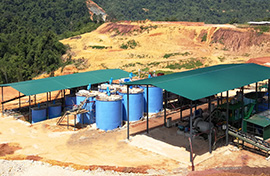-
 E-mail
canye8654065@gmail.com
E-mail
canye8654065@gmail.com
-
 Call Us
0086 13641173523
Call Us
0086 13641173523
 E-mail
canye8654065@gmail.com
E-mail
canye8654065@gmail.com
 Call Us
0086 13641173523
Call Us
0086 13641173523
 Home
Guides
Helpful Guide
How to Extract Gold from Rocks, Pyrite, and Quartz: A Practical Guide to Mining Gold
Home
Guides
Helpful Guide
How to Extract Gold from Rocks, Pyrite, and Quartz: A Practical Guide to Mining Gold
2025-03-21 Views: 450
Warm Tip: If you want to know more information, like quotation, products, solutions, etc., please Click here ,and contact us online.

Rocks often hide tiny gold particles, either as free gold or locked within minerals. Extracting gold from rocks requires a blend of physical and chemical steps. Here’s how to do it:
· What You Need: Hammer, mortar and pestle, jaw crusher or ball mill
· Process: Break rocks into smaller pieces (about 1-2 cm), then grind them into a fine powder. The finer the powder, the easier it is to access gold.
· Tip: Wear safety gear—rock dust can be hazardous.
· What You Need: Gold pan, water.
· Process: Add powdered rock to a pan with water. Swirl gently to let heavy gold settle while lighter materials wash away.
· Efficiency: Works best for free gold (not chemically bound). Expect 50-70% recovery for coarse particles.
· What You Need: Eco-friendly reagent (e.g., Cnlite, Cnfree), protective gloves, container.
· Process: Mix powdered rock with water and a leaching agent (e.g., 1 g/L Jinchan at pH 11). Stir for 24-48 hours, then filter to collect gold-rich solution. Precipitate gold using zinc or activated carbon.
· Safety Note: Avoid cyanide unless trained—opt for non-toxic alternatives.
A: Gold in rocks is often visible or near the surface. Crushing exposes it, while leaching dissolves microscopic particles. For small-scale miners, this method balances cost and yield.
Pyrite, someone called it “fool’s gold”, often contains real gold trapped within its iron sulfide structure (FeS₂). Extracting it requires breaking these bonds. Here’s the process:
· You Need: Kiln, ventilation.
· Process: Heat pyrite to 600-700°C in an oxygen-rich environment. This burns off sulfur as sulfur dioxide(SO₂) gas, leaving iron oxide and freeing gold.
· Caution: Perform outdoors—SO₂ is toxic!
Step 2: Crushing the Residue
· What You Need: Crusher or mortar.
· Process: Grind roasted pyrite into powder to expose gold particles.
· Tip: Check for visible gold flecks under a magnifying glass.
Step 3: Leaching or Smelting
· Leaching Option: Use an eco-friendly reagent (e.g., Cnlite at 0.5-1 g/L). Soak for 24 hours, then precipitate gold.
· Smelting Option: Mix powder with flux (borax, soda ash), heat to 1200°C in a crucible, and pour into a mold to separate gold.
· Efficiency: Leaching yields 80-90%; smelting suits larger visible gold.
A: Pyrite locks gold in its crystal lattice. Roasting breaks this bond, and subsequent steps isolate the metal. This method suits sulfide-rich ores common in gold deposits.
Quartz veins often host high-grade gold, visible as specks or microscopic inclusions. Extracting it combines mechanical and chemical techniques:
· What You Need: Sledgehammer, chisel, or rock crusher.
· Process: Smash quartz into small chunks (2-5 cm). Look for visible gold veins—white quartz with yellow streaks is a good sign.
· Tip: Work in a well-ventilated area to avoid silica dust.
· What You Need: Ball mill or hand grinder.
· Process: Pulverize quartz into a sand-like consistency. This exposes gold trapped within.
· Note: Finer particles (100-200 mesh) improve recovery.
· Gravity Option: Pan the powder to collect visible gold. Works for free-milling quartz (recovery 60-80%).
· Leaching Option: Use a green reagent (e.g., Cnlite, 1 g/L, pH 10-11). Soak for 12-24 hours, then extract gold with carbon adsorption.
· Yield: Leaching can hit more than 90% for fine gold.
A: Quartz often holds free gold or gold locked in micro-fractures. Grinding liberates it, and leaching targets the tiniest specks, making this ideal for vein deposits.
Source | Best Method | Pros | Cons | Recovery Rate |
Rocks | Panning+Leaching | Simple, low-cost | Slow for fine gold | 50-90% |
Pyrite | Roasting+Leaching | High yield for sulfides | Requires heat, ventilation | 80-95% |
Quartz | Grinding+Leaching | Targets vein gold | Dust hazard, equipment | 60-90%+ |
· Protect Yourself: Wear masks, gloves, and goggles—rock dust and chemicals pose risks.
· Go Green: Skip cyanide for reagents like Cnlite or Cnfree. They’re safer and meet modern regulations.
· Dispose Wisely: Neutralize leaching waste (e.g., adjust pH to 7) before disposal.
While traditional methods work, they’re often slow or risky. That’s where Cnlite comes in—a cutting-edge, eco-friendly gold leaching solution. With a 95% recovery rate across rocks, pyrite, and quartz, it’s non-toxic, cost-effective (20% cheaper than competitors), and easy to use. Tested in real mines, Cnlite performs like cyanide, non toxic. Ready to extract gold smarter? Contact us for a free sample today!
Extracting gold from rocks, pyrite, or quartz doesn’t have to be complex or harmful. With the right tools—hammers, eco-friendly reagents or even ball mill—you can unlock nature’s riches sustainably.
Got questions or need gear? Contact us immediately—we’re here to help you strike gold responsibly!
No. 188, Xinhai Street, high-tech Industrial Park, Fushan District, Yantai, Shandong, China.

Please leave your message here! We will send detail technical info and quotation to you!